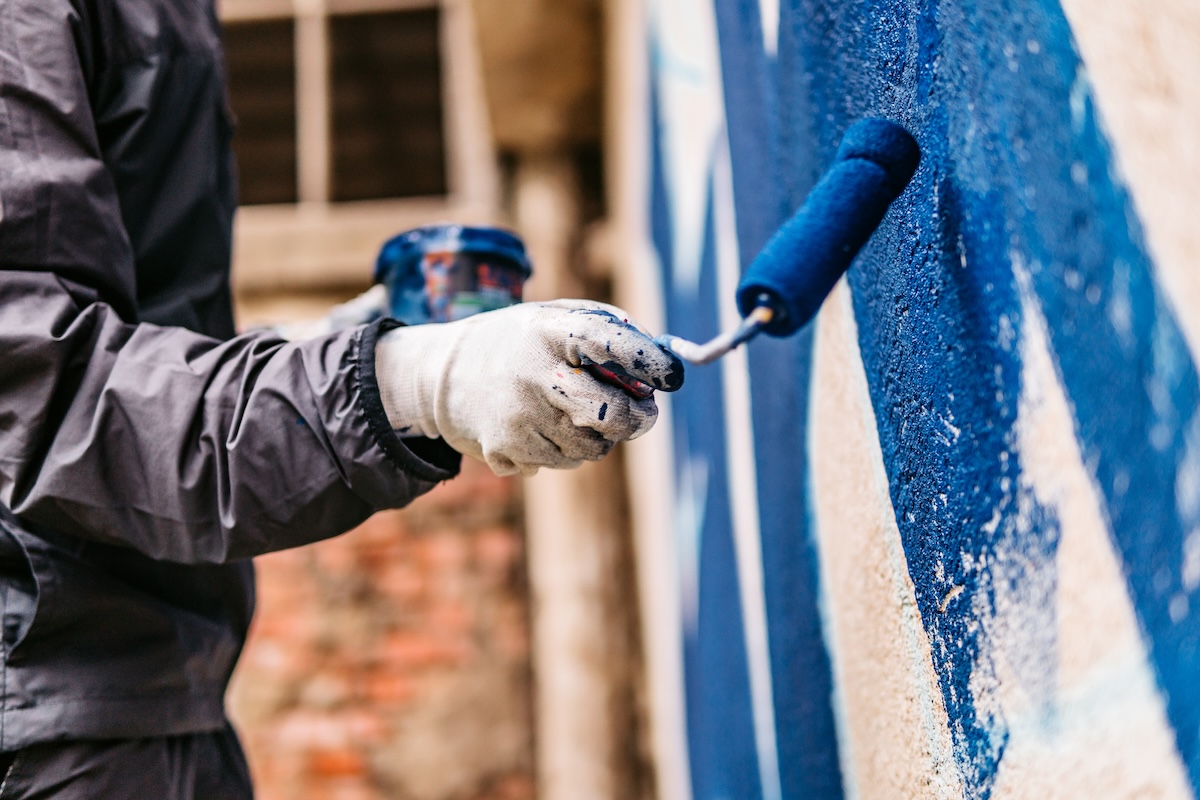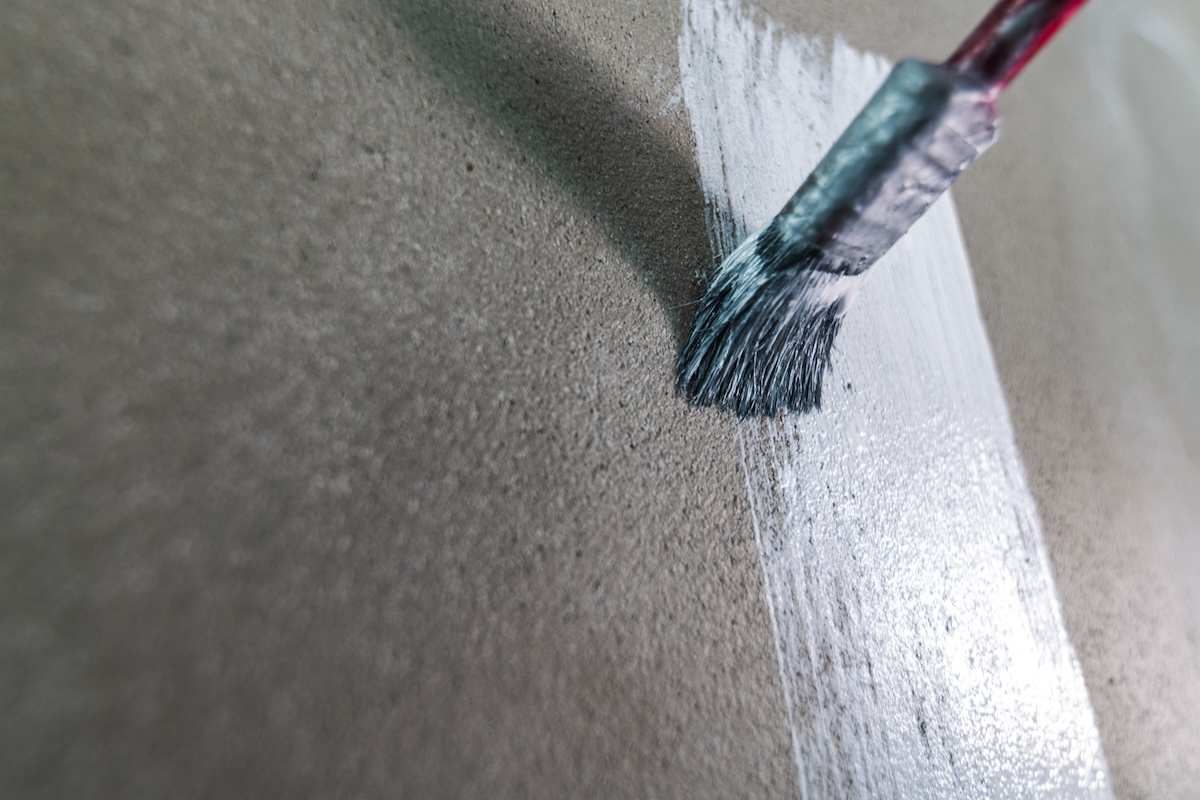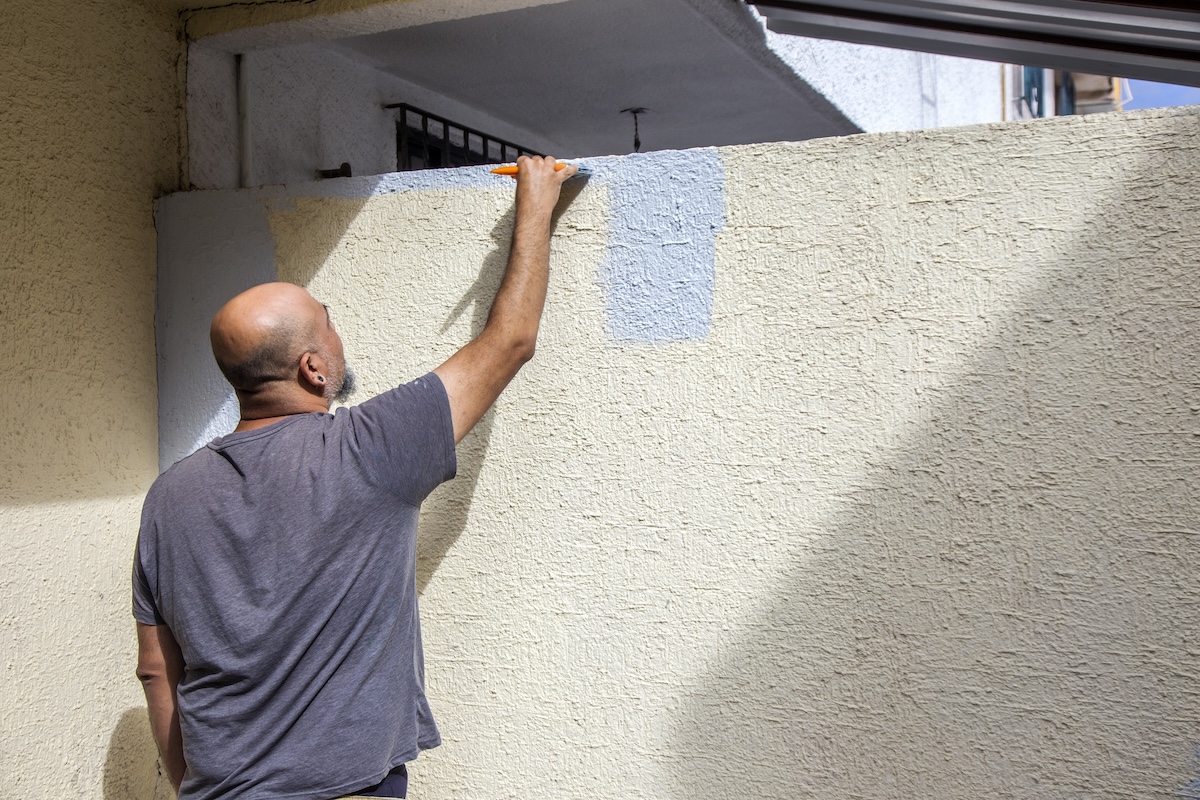

We may earn revenue from the products available on this page and participate in affiliate programs. Learn More ›
To paint concrete successfully, so that it looks good and lasts a long time, proper preparation is key. If you are tired of looking at a dingy concrete garage floor or patio, you can update the look without spending a lot of money or time tearing out and replacing the concrete. As concrete is a porous surface, you can achieve a fresh and pleasing concrete surface with some carefully applied paint.
“While painting concrete can create an impressive transformation, it requires careful preparation and application to ensure longevity,” says Julie Fisher, product manager, Dutch Boy Paints.
So before you pick up a paint brush or roller, review the steps below on how to paint concrete so you can achieve satisfying results on any concrete surface you choose to paint, be it the garage floor, basement floor or wall, outdoor patio, or any other part of your property.
Tools & Materials
Bobvila.com may earn a commission from purchases made through these links.
- Sanding block with multiple grits
- Primer
- Paint
- Sealer (optional)
- Concrete cleaner
- Drop cloth
- Paint roller frame
Project Overview
Working time: 1 hour per 100 square feet
Total time: 5 hours per 100 square feet
Skill level: Intermediate
Estimated cost: $100+
Before You Begin

A well-painted concrete surface can last for up to a decade or more, so it’s important to methodically follow all of the preparation steps and not rush the process. Before you start laying out a drop cloth and applying paint, check the weather forecast to pick a period when it will likely be clear for a few days. Then, carefully choose the best paint and paint tools for the location and use.
Choose the right primer.
While primers aren’t always necessary for some surfaces like patios and walkways, whether or not to use a primer can also depend on the type of paint you choose. The instructions for some concrete paints—found on the can—will include a primer step. Even though not every paint requires a primer, many experts recommend always applying a primer since it can help increase the adhesion and longevity of any paint job. And the longer a paint job lasts, the less often you need to paint it.
Among the primer options on the market, Loxon Concrete and Masonry Primer from Sherwin-Williams is designed for concrete. Harry Adler from Adler’s hardware store in Providence, Rhode Island, says, “Premium 100 percent acrylic exterior primers such as C2 Paint C3000 work perfectly!”
Choose the right paint.
While oil-based paints are the worst option for concrete, there are a variety of quality paints from several brands that work well on concrete, so it can be tough to recommend just one without knowing the details about the location and use of the concrete you want to paint. “Determining the best paint for concrete really depends on the specific project,” says Dennis Fiorilli, Director of Product Excellence at Sherwin-Williams.
“For high-traffic areas such as walkways and porches, opt for paints that offer maximum protection, excellent durability, and UV/fade resistance,” says Fisher. “Look for paints that offer additional features such as an anti-skid formula for excellent traction.”
Here are more helpful guidelines to choosing the best paint for various concrete surfaces:
- Interior flooring: C2 Cabinet & Trim is a good choice for painting concrete floors inside the home.
- Exterior concrete: For concrete patio paint and other paint for concrete outdoors, “elastomeric coatings are typically used here—especially with exterior block and porous surfaces because they expand and contract to bridge gaps and have stronger weatherproofing qualities,” says Mitchell.
- Wet applications: Interior concrete in wet applications would benefit from a paint like C2 Guard for Masonry to protect the surface from cracking and peeling.
“The finish of the paint can also affect the durability and appearance of the concrete surface. For a smooth, sleek finish, consider using a semi-gloss or high-gloss paint,” says Fisher. “These finishes are easier to clean and can enhance the look of more decorative concrete surfaces. For a more natural, subtle look, a satin finish is best.”
If you have several different small areas of concrete to paint, and want to choose just one that can work in multiple locations, Mitchell says,“As long as the concrete is cured, stable, smooth, and doesn’t have a high pH it responds well to any good quality acrylic paint, like Sherwin-Williams Duration Home.”
BobVila.com staffers have also conducted hands-on tests of some popular concrete paints. For our recommendations, be sure to consult our tested guide to the best paints for concrete.
Choose the right sealer.
Sealing painted concrete can help extend the life of the paint job. However, a sealer isn’t necessary in every application. For example, vertical surfaces or areas that don’t experience regular wear don’t benefit the same as those surfaces that have heavy use.
Sealers also do not have to be used with paint. You can skip the paint and just seal the concrete with a clear coat, if you don’t want to change the color of the concrete floor but want to add some durability to the concrete surface.
For areas that experience heavy traffic or harsh weather, a sealer like Dutch Boy Water-Based Natural Look Satin Concrete Sealer can help protect the painted surface.
Choose appropriate tools.
Not every paint brush and roller is made for every surface and paint. When painting a porous surface like concrete, Adler recommends “a high-quality paint brush, ½- or ¾-inch nap roller cover, or airless or HVLP (high-volume, low-pressure) sprayers” as the best tools for applying paint to concrete.
Fisher adds: “Use a roller such as Purdy ½- to ¾-inch white dove roller covers, designed for rough surfaces or Purdy ⅜-inch white dove roller covers for smoother surfaces to apply the paint in thin, even coats.”
When choosing a paint brush, a regular medium-size paint brush enables you to achieve good coverage when painting corners and edges, whether you’re working with an interior or exterior space.
Painting Concrete in 6 Steps

If you’ve painted brick or stone, you are ahead of the game for painting concrete. As a porous surface, concrete takes paint in a different way than drywall or finished wood. It’s helpful to start in an inconspicuous location, so you can gain confidence and execute the rest of the project the way you envision.
As you work to follow the steps below, make sure to apply multiple coats and wait for each to coat to dry before painting again.
Step 1: Clean the concrete surface.
In order to successfully paint concrete, the surface must be fully cured, clean, dull, and dry. Either use a degreaser or a concrete cleaner with a pressure washer to remove any dirt and oil. You may also use a metal-bristle brush to spot clean areas, too. Wait for the surface to fully dry before moving on to the next step.
Step 2: Repair cracks and damaged areas.
Over time, concrete may develop cracks or become marred. Before painting, repair any damage with concrete filler, which also acts as a primer for the painted surface.
- Use the patch compound to fill in all holes, scratches, and gouges in the concrete.
- After allowing sufficient curing time, sand the repaired areas until they are smooth with the surrounding concrete.
- Clean the surface to remove any dust or debris.
Step 3: Apply concrete primer.
First, place a drop cloth near your work area, so you have a staging area for the project. Then, using your paint brush, apply a coat of primer to the perimeter of the concrete surface. If you are painting a floor, start at the farthest corner from the exit so you can paint your way out of the space. Then use a paint roller to apply the primer to the rest of the surface. Again, paint your way out of the space.
After the primer is dry, inspect the concrete to make sure it is evenly covered in primer. Touch-up any spots that were missed in the first pass.
Tip: When painting concrete walls with a roller, you can start at the bottom of the wall and work your way up, paint in a W pattern, or start at the top and work down. Any of these techniques can be successful at reducing potential drips, if you apply a light coat of paint.
Step 4: Apply the first coat of paint.
Sweep the area or wipe it down with a dry cloth, depending on the orientation of the surface. Now you’re ready to start applying the chosen paint color. Fisher says: “Multiple thin coats are better than one thick coat as they reduce the risk of peeling. Allow each coat to dry fully before applying the next.”
Use a paint brush to apply an initial coat of paint over the perimeter of the area. Next, use a paint roller to fill in the sections that you didn’t coat with the brush. If you’re painting a concrete floor, remember to start on the far side of the room, so you end up finishing near a doorway or another convenient stepping-off point. Allow the first coat of paint dry for at least 16 hours or the length of time that is recommended on the paint can.
Step 5: Apply a second and final coat of paint to the concrete.
Apply the second coat of paint in the same way that you applied the first. This time around, however, press down firmly into any areas the first coat didn’t penetrate. Before considering the project complete, let the second coat dry for about 5 days, particularly if the painted surface is a heavily trafficked floor.
Step 6: Apply concrete sealer (optional).
Following the same method as priming and painting, apply concrete sealer to the perimeter of the painted surface and then the field after it is fully dried to the manufacturer’s specifications. Not every situation requires a sealing coat, but it can extend the life of the paint job.
Tip: If there are any protruding lumps or bumps that appeared after the paint dries, it may be because the concrete surface wasn’t fully clean and dry before application. Sand any raised areas or where the paint failed to adhere. If you are sanding between paint coats, don’t forget to sweep again, too.
Final Thoughts
Painting concrete is an easy way to update the look of a garage or basement floor without having to invest a great deal of time and money into a bigger remodeling project. By prepping the surface carefully, choosing the proper paint and tools, and working methodically, you can refresh the look of a concrete surface so it better suits your home’s style.
FAQs
The best concrete paint depends on the location and function of the concrete. Any good quality acrylic paint can adhere to clean and dry concrete. Never use oil-based paint on concrete.
No, you do not always need to prime concrete before painting. It’s recommended for most applications, however, as primer helps increase the adhesion of paint. Even more important than primer, though, is that the concrete surface is fully cured, clean, dry, and free of any oils.
Yes, you can apply paint or stain directly on concrete that is fully cured and free of oils and debris.
It is possible to remove paint from concrete. Adler says: “Removing dried paint from concrete is not easy. A chemical paint and varnish remover works best, but may take several applications since the concrete is porous.” Fiorilli also suggests: “A coating can be removed from concrete by high pressure wash or using a paint stripper designed for concrete.”
